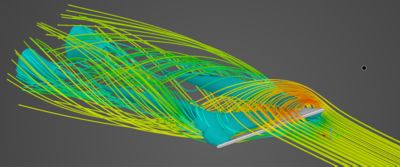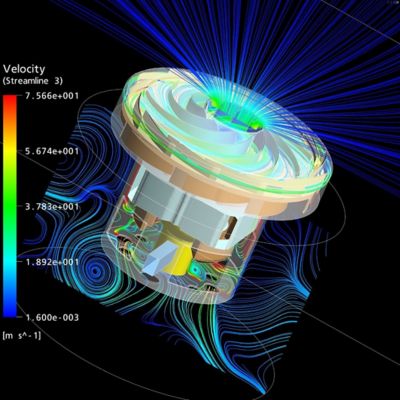Case Study
-
-
학생용 무료 소프트웨어에 액세스하기
차세대 엔지니어에게 힘을 실어주는 Ansys
학생들은 세계적 수준의 시뮬레이션 소프트웨어를 무료로 이용할 수 있습니다.
-
지금 바로 Ansys에 연결하십시오!
미래를 설계하기
시뮬레이션이 다음 혁신을 어떻게 지원할 수 있는지 알아보려면 Ansys와 연결하십시오.
국가
무료 트라이얼
제품 및 서비스
학습하기
회사 정보
Back
제품 및 서비스
“Through hands-on experience with Ansys Discovery software, Ansys Fluent simulation, and the Ansys CFX solution in both introductory and advanced CFD classes for bachelor's and master's students, we bridge theoretical learning with practical application. This approach not only enhances course satisfaction, but also deepens understanding of fundamental concepts such as boundary conditions, grid studies, accuracy, time-step selection, and turbulence models. Ultimately, students gain proficiency in solving real-world computational fluid dynamics (CFD) challenges, preparing them for successful careers as engineers in the industry.”
— Philipp Epple, Prof. Dr. -lng., Coburg University of Applied Sciences
Today, theoretical classes in CFD must be complemented with practical exercises using a Navier-Stokes solver. Coburg University of Applied Sciences in Coburg, Germany, offers CFD classes for bachelor’s and master’s students, along with advanced master’s classes. In the introductory classes, the fundamental theory covers the derivation of Navier-Stokes equations and a thorough understanding of each of its terms, the analytical solutions of fundamental flows (as in the flow in pipes or over a flat plate), the derivation of RANS equations, and the discussion of turbulent stresses and turbulence models.
This theory is accompanied with hands-on CFD classes that involve learning workflows with Ansys Workbench™ simulation integration platform and Ansys CFX® CFD software, including geometry generation, mesh creation, boundary condition setting, grid refinement, and turbulence model selection.

Figure 1. Prof. Dr.-Ing. Philipp Epple teaches CFD at Coburg University of Applied Sciences.
Challenges
To learn CFD, hands-on experience with Navier-Stokes solvers like Ansys Discovery™ 3D product simulation platform, Ansys Fluent® fluid simulation software, and CFX software is crucial.
The challenge of CFD lectures is to teach the theory (i.e., derive the fundamental equations, continuity, momentum, and energy equations); practice with these equations; teach discretization methods, finite differences and finite volumes to solve these equations numerically; and enable the students to solve real-world CFD problems.
In mechanical engineering, students must learn how to solve complex flow problems and to perform real-world product development and optimization in fluid mechanics. This can only be accomplished with professional CFD software. Discovery software, Fluent software, and CFX software are used for this purpose in teaching, as these are state-of-the art software packages used in industry and academia.

Figure 2. Simulation of the flow around a delta wing with Discovery software

Figure 3. Flow visualization around a delta wing
Engineering Solutions
The CFD classes are divided into theoretical classes and practical classes using Ansys. In the practical classes, it is important that students learn the whole workflow: generating or impoting geometry, generating and studying grids, setting up boundary conditions and monitor points, selecting the time step and turbulence model, and solving and post-processing the solution using visualization features like contour plots, stream lines, and vector plots. In addition to this, students learn how to perform quantitative post-processing and export the quantitative results to CSV files. With Discovery software, the students learn:
- How to explore different flows, like the flow around a cylinder, airfoil, or pipe
- How to change and immediately see the effects of the boundary conditions and geometry modifications

Figure 4. Simulation of the flow through a vacuum cleaner fan with CFX software

Figure 5. Coburg University of Applied Sciences
Additionally, students gain hands-on experience with Ansys Meshing™ 2D/3D mesh generation and analysis capability, Ansys TurboGrid™ turbine blade meshing software, and the ICEM capability for generating various grid types and refining grids based on theoretical concepts. Practical applications include uncertainty estimation via Richardson extrapolation in CFX software, studying turbulence model impacts with the backward-facing step, and simulating rotating frames of reference with axial and radial fans.
Benefits
When solving complex and real-world simulation problems, CFD classes have a theoretical part that is necessary in understanding CFD and writing code. However, to meet industry and academia requirements, engineering simulation is needed. Therefore engineering simulation using Discovery software, Fluent simulation, and the CFX tool is included in classes. The software helps students develop an understanding in fundamental and complex flows. For example, students learn how to understand the differences between incompressible and compressible flows at subsonic and supersonic velocities. Additionally, students learn how to solve real-world problems in fluid mechanics, such as the flow over airfoils, cars, or an entire aircraft, as well as the flow through turbomachines.
시작하기
엔지니어링 과제에 직면하고 있다면우리 팀이 도와드리겠습니다. 풍부한 경험과 혁신에 대한 헌신을 가지고 있는 우리에게 연락해 주십시오. 협력을 통해 엔지니어링 문제를 성장과 성공의 기회로 바꾸십시오. 지금 문의하기